

A classical two week wildlife and cultural tour of India, that takes you to some of the best known sights in North India, the Temple towns of Varanasi and Khajuraho, the city of the Taj Mahal, Agra, and the Pink city of Jaipur. In addition, this trip takes you to two of India’s best known Tiger Reserves, Bandhavgarh in Central India, and Ranthambore in Rajasthan, giving you ample opportunities to sight the Royal Bengal Tigers in the wild.
Day 01 – Arrive Delhi
You will be met at the airport by Pan India Tourism representative and transferred to the hotel and assisted with check in formalities.
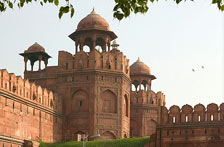 Delhi is the capital of India, and its third largest city. Delhi consists of two parts – New Delhi, the city created in 1911 as the imperial capital of India by the British and the Old Delhi, the Muslim capital of India between the 17th and 19th centuries. In fact there have been at least eight cities on the site of modern Delhi – the earliest known settlement, Indraprastha, featured in the epic Mahabharata over 3000 years ago. Though not always the capital, Delhi has always been an important city of northern region of the subcontinent.
Delhi is the capital of India, and its third largest city. Delhi consists of two parts – New Delhi, the city created in 1911 as the imperial capital of India by the British and the Old Delhi, the Muslim capital of India between the 17th and 19th centuries. In fact there have been at least eight cities on the site of modern Delhi – the earliest known settlement, Indraprastha, featured in the epic Mahabharata over 3000 years ago. Though not always the capital, Delhi has always been an important city of northern region of the subcontinent.
Overnight in Delhi.
Day 02 – In Delhi
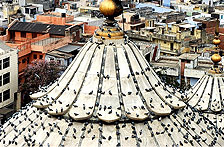 After breakfast, you will be picked up from your hotel and taken for a guided sightseeing tour of Old & New Delhi. Tour includes visits to the following places of interest:
After breakfast, you will be picked up from your hotel and taken for a guided sightseeing tour of Old & New Delhi. Tour includes visits to the following places of interest:
Red Fort: Derived from a Hindi word Lal, which means red and Quila which means fort. It is laid out along the river Yamuna as an irregular octagon, surrounded by a wall of about 2.4 kms in circumference and is built of red sandstone. Shah Jahan started construction of the massive fort in 1638 and it was completed in 1648. The fort has two main entrances, the Delhi Gate and the Lahori Gate, which faces the famed Chandni Chowk market. The fort has Diwan – e – Am (hall for public audience); Diwan – e – Khas (hall for private audience); Rang Mahal (a water-cooled apartment of royal ladies); Pearl mosque, built of white marble.
Jama Masjid: In Old Delhi, an architectural extravaganza of Shah Jahan, is the country’s largest mosque where thousands of Muslims offers prayers even today. It was built in 1658. The flight of stairs and its large courtyard are marvels of architecture.
Chandni Chowk (Silver Street): It is the colourful main street and shopping bazaar of Old Delhi and is today one of the country’s best known wholesale market for textiles, electronic goods and watches. The entire area was designed by Jahanara Begum, Shah Jahan’s favourite daughter and was then inhabited by the well-to-do families of the time. Around the area is the famed Paranthawale Gali, known for its delicious paranthas, Dariba Kalan, the gold market and well-known sweetmeats shops.
Raj Ghat : On the banks of river Yamuna, a simple square platform of black marble marks the spot where Mahatma Gandhi was cremated following his assassination in 1948. A commemorative ceremony takes place each Friday, the day he was killed.
Birla Mandir: Close to Connaught Place, it was built by the industrialist Raja Baldev Birla in 1938. The temple is an important prayer site and contains idols of several deities.
India Gate: This 42 meter high, free standing arch was built in 1931.It was originally called All India War Memorial in the memory of the 90,000 soldiers of the Indian Army who died in World War I. The names of the soldiers are inscribed all along the walls of the arch. In 1971, the eternal flame was lit here to honour the Amar Jawan (Immortal Soldier).
Rashtrapati Bhavan (President’s House): It is the official residence of President of the country. Designed by Lutyens, it was the official residence of the Viceroy when the British ruled India.
Humayun’s Tomb: It was built by Haji Begum (widow of Humayun) in 1565 – 66, nine years after his death.
Qutub Minar: This magnificent structure in the southern part of the capital was built by the Muslim King; Qutab – ud – din Aibak in 1199 A.D. Minar (tower) is 72.5 meters high and has as its base a mosque.
Bahai’s Temple: It is a very recent architectural marvel of the Bahai faith and is visible from several spots in South Delhi. It is a lotus shaped and has rightly been given the name.
Overnight in Delhi.
Day 03 – Fly Delhi - Varanasi
After leisurely breakfast at the hotel, you will be met by our representative and assisted with check-out formalities. You will then be transferred to the airport in time to board flight for Varanasi.
Varanasi - Varanasi, the ‘eternal city’ is one of the most important pilgrimage sites in India and also a major tourist attraction. Situated on the banks of the sacred Ganges, Varanasi has been a center of learning for over 2000 years. Besides being a pilgrimage center, it is considered an auspicious place to die, ensuring an instant route to heaven. Varanasi is still a center of learning, especially for Sanskrit scholars, and students flock here from all over India.
The old city of Varanasi is situated along the west bank of the Ganges and extends back from the riverbank ghats in a winding collection of narrow alleys. They’re too narrow for anything but walking and tall houses overhang the picturesque, though hardly clean, lanes. The town extends from Raj Ghat, near the bridge, to Asi Ghat, near the university.
You will be met at the Varanasi airport by our representative and transferred to the hotel and assisted with check in formalities.
Overnight in Varanasi.
Day 04 - Fly Varanasi – Khajuraho
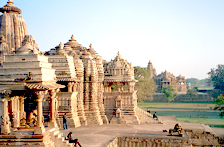 The day starts early with a dawn boat ride on the holy river The Ganges. Your guide and driver will pick you up from your hotel and take you to the river Ganges. At dawn, the city and the river are coming alive, the light is magical and Varanasi looks an exotic place. A highlight of any trip to Varanasi - this is an incredible scene, as multitudes of devotees comes to the river to pay homage to the Sun God. The riverfront, as seen from a boat at sunrise, is a spiritually uplifting sight. Hinduism, deep and mystical, is everywhere: in a decorated doorway; in a glimpse of a glittering temple; in the sound of a sacred bell; in the chant of the priests; and in the fragrance of flower oblations.
The day starts early with a dawn boat ride on the holy river The Ganges. Your guide and driver will pick you up from your hotel and take you to the river Ganges. At dawn, the city and the river are coming alive, the light is magical and Varanasi looks an exotic place. A highlight of any trip to Varanasi - this is an incredible scene, as multitudes of devotees comes to the river to pay homage to the Sun God. The riverfront, as seen from a boat at sunrise, is a spiritually uplifting sight. Hinduism, deep and mystical, is everywhere: in a decorated doorway; in a glimpse of a glittering temple; in the sound of a sacred bell; in the chant of the priests; and in the fragrance of flower oblations.
Return to hotel. After leisurely breakfast, you will be picked up again from your hotel for the guided tour of Varanasi. Tour includes visits following places of interest:
Asi Ghat: It is one of the five special ghats which pilgrims are supposed to bathe from in order and on the same day. The order is Asi, Dasaswamedh, Barnasangam, Panchganga and finally Manikarnika.
Durga Temple: It is commonly known as the Monkey Temple due to the many monkeys that have made it their home. It was built in the 18th century by a Bengali maharani and is stained red with ochre. The small temple is built in North Indian Nagara style with a multi-tiered shikharas (spires). This temple is also closed to non-Hindus, however, you can look down on the temple from a walkway at the top.
Kashi-Vishwanath Or Golden Temple: Dedicated to Vishveswara Siva as the Lord of the Universe, the Golden Temple is across the road from its original position. Aurangzeb destroyed the original temple and built a mosque over it – traces of the earlier 1600 temple can be behind his mosque. The present temple was built in 1776 by Ahalya Bai of Indore, and the gold plating on the towers was provided by Maharaja Ranjit Singh of Lahore. Next to the temple is the Gyan Kupor Well – the well of knowledge. Non-Hindus are not allowed into the temple but can view it from upstairs in a house across the street.
Later you will be met by our representative and assisted with check-out formalities. Then you will be transferred to airport in time to board flight for Khajuraho.
Khajuraho: - Khajuraho was once the capital of the Chandela Rajputs of Bundelkhand. It is home to the world famous 10th century Khajuraho temples. These temples represent some of the most exquisite specimens of medieval Hindu architecture and sculpture in the country.
You will be met at Khajuraho airport by our representative and transferred to hotel and assisted with check in formalities.
No activities are scheduled for this day. Spend rest of the day enjoying the hotel facilities or exploring the city on your own.
Overnight in Khajuraho.
Day 05 – Drive Khajuraho – Bandhavgarh (250 kms / 05 hrs)
After breakfast at hotel, you will be picked up from your hotel and taken for a guided sightseeing tour of Khajuraho Tour includes visits to the following places of interest:
Eastern Group Of Temples – It’s includes the Lakshmi and Varaha Temple, the Lakshmana Temple, the Kandariya Mahadev, the Mahadeva Temple; the Devi Jagadamba Temple, the Chitragupta Temple and the Vishwanath Temple.
Western Group Of Temples - Also houses the Matangesvara Temple, the only temple where worship continues and the Chausath Yogini Temple, presently in ruins and believed to be the oldest temple in Khajuraho. The Eastern Group of temples houses the Parasvanath Temple, the largest and finest Jain temple in the city as well as the Adinath Temple, the Shantinath Temple, the Ghantai Temple, the Javari Temple, the Vamana Temple and the Brahma and Hanuman Temple.
Later in the afternoon, you will be met by our representative at hotel and assisted with check out formalities. You will then start your drive to Bandhavgarh.
Bandhavgarh National Park - Situated in Central India is one of the most recently declared reserve under India’s most successful conservation project called “Project Tiger”. Formerly a Royal hunting reserve of the princely state of Rewa where the first White Tiger in the wild was ever found. The Bandhavgarh National Park abounds in many of India’s rare and endangered animals: Chital, Sambar, Muntjak (Barking Deer), Nilgai, Chinkara, Chowsingha (Four-horned antelope), Gaur (the Largest Oxen), Sloth Bear, Wild Boar, Leopard and Tiger. Bandhavgarh is undoubtedly one of the best reserve for seeing Indian Tiger. It has vast variety of bird life. For over 275 species of birds are found here such as Horn Bills, Golden Orioles, parakeets, Peacocks, Eagles, and Vultures etc. The Park is situated in 450 Sq. Kms of mixed forest with major Tree being Sal (Shorea robusta) tree and Bamboo. Many of the valleys have meadows, which form the favorite places for most animals. The terrain is undulating with 32 small hills within the Park, the largest and central one abruptly rising 460 meters thus was chosen as the ideal site for Bandhavgarh Fort.
On arrival at Bandhavgarh , you will be assisted with check in formalities into your resort.
Overnight in Bandhavgarh.
Day 06 – In Bandhavgarh
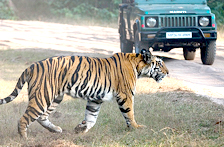 Morning and Evening Game rides into the Bandhavgarh National Park. Safaris in Bandhavgarh are conducted using Jeeps. Short Elephant rides are also available, for tiger viewing. Resident Naturalists are also at hand, to enhance your safari experience. Overnight in Bandhavgarh.
Morning and Evening Game rides into the Bandhavgarh National Park. Safaris in Bandhavgarh are conducted using Jeeps. Short Elephant rides are also available, for tiger viewing. Resident Naturalists are also at hand, to enhance your safari experience. Overnight in Bandhavgarh.
Day 07 - Overnight train Bandhavgarh - Agra
The day starts early with a morning game safari into the Bandhavgarh National Park. . Safaris in Bandhavgarh are conducted using Jeeps. Short Elephant rides are also available, for tiger viewing. Resident Naturalists are also at hand, to enhance your safari experience.
Early evening, drive to Umaria (nearest railway station from Bandhavgarh), and board the overnight train to Agra (2055 / 1015 hrs).
Overnight on board train.
Day 08 - Arrive Agra
You will be met at Agra Railway Station by our representative and transferred to hotel and assisted with check in formalities
Agra - Agra, situated on the bank of Yamuna River, is home to India’s most famous landmark, the Taj Mahal. Agra was the capital of Mughal Empire in the 16th & 17th centuries and its superb monuments date from this era.
Later in the afternoon, you will be picked up from your hotel and taken a guided sightseeing tour of Agra. Tour includes visits following places of interest:
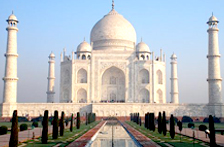 Taj Mahal: The Taj Mahal was constructed by Emperor Shah Jahan in memory of his wife Mumtaj Mahal who died during the birth of her child in 1631. The construction is said to have taken 22 years to complete, starting from 1631, with over 20,000 craftsmen working round the clock. Artisans and experts were brought from France and Italy and the main architect was from Iran.
Taj Mahal: The Taj Mahal was constructed by Emperor Shah Jahan in memory of his wife Mumtaj Mahal who died during the birth of her child in 1631. The construction is said to have taken 22 years to complete, starting from 1631, with over 20,000 craftsmen working round the clock. Artisans and experts were brought from France and Italy and the main architect was from Iran.
Agra Fort: Construction of the massive red sandstone Agra Fort on the bank of Yamuna river was begun by Emperor Akbar in 1565 and it was to be predominantly a military structure until his grandson, Shah Jahan, added more palatial accommodations. There are a number of exquisite buildings within its portals such as Samman Burj, where Shah Jahan was held captive by his son, Moti Masjid, a white marble mosque, Diwan – e – Am, Diwan – e – Khas, Jahangir’s Palace, Khaas Mahal and Shish Mahal.
Overnight in Agra.
Day 09 - Drive Agra – Ranthambore (280 kms / 6 hrs)
After breakfast at hotel, you will be met by our representative and assisted with check-out formalities. You will then start your drive to Ranthambore, the second National park that you visit on your Wildlife safari in India. Stop enroute at Fatehpur Sikri for guided tour of this ancient capital.
Fatehpur Sikri: the deserted capital of Emperor Akbar approximately 35 kms outside Agra. Built in the 16th century, this city was abandoned 12 years later due to a scarcity of water. The entire city of Red sand stone (sand stone palaces and temples) is virtually intact and a site worth seeing is the 54 m high main entrance - The Buland Darwaza, The gate of victory constructed to commemorate Akbar’s victory in Gujarat.
After the visit, continue your drive to Ranthambore.
Ranthambhore - The Ranthambore National Park is one of the prime examples of Project Tiger's conservation efforts in Rajasthan. It covers an area of over 400 sq km with many steep crags embracing a network of lakes and rivers. Atop one of these hills, the 10th century Ranthambore Fort stands like a silent sentinel. The terrain is a blend of impregnable forests and open bush land. The forest is the typically dry deciduous type with dhok being the most prominent tree. Ranthambore is best known for its tiger population, and tiger sightings are common here. Apart from tigers, the park has its share of panthers, too. Kachida Valley is believed to be the place to sight these rather elusive cats. One can also find marsh crocodiles, hyenas, jungle cats and sloth bears apart from Chital, Nilgai, and Chinkara. The avian population comprises of black storks, quails, Bonelli's eagles, spur fowls, crested serpent eagles and painted storks. During the winter months, the park attracts a lot of migratory birds, including a variety of ducks. It is the ideal park for wildlife photography.
On arrival at Ranthambore, you will be met by our representative and assisted with check in formalities into your resort.
Rest of the day is at leisure and can be spent enjoying the resort’s facilities.
Overnight in Ranthambore.
Day 10 - In Ranthambore
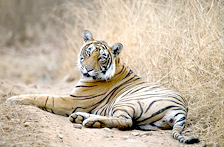 The day starts early with a morning game safari into the Ranthambore National Park. . Safaris in Ranthambore are conducted using Jeeps. Resident Naturalists are also at hand, to enhance your safari experience.
The day starts early with a morning game safari into the Ranthambore National Park. . Safaris in Ranthambore are conducted using Jeeps. Resident Naturalists are also at hand, to enhance your safari experience.
Return to resort for breakfast. Spend rest of the morning relaxing at the hotel. Later in the afternoon, you will be picked up again from your resort for an afternoon game safari into the Ranthambore National Park.
Overnight in Ranthambore.
Day 11 - Drive Ranthambore – Jaipur (180 kms /03 hrs)
The day starts early with a morning game safari into the Ranthambore National Park. . Safaris in Ranthambore are conducted using Jeeps. Resident Naturalists are also at hand, to enhance your safari experience.
Return to Resort for breakfast. Later, you will be met by our representative and assisted with check out formalities. You will then drive to Jaipur.
Jaipur - It is the capital of Rajasthan, and known as the “Pink City” because of the pink colored buildings in its old city. It is situated on a dry lakebed in a somewhat arid landscape, surrounded by barren hills surmounted by forts and crenellated walls. Founded in 1727 by Maharaja Jai Singh II, who was careful to cultivate good favour with the ruling Mughals, he laid out the city with rectangular blocks according to ancient Hindu architecture. It is a wonderful city for shopping.
On arrival at Jaipur hotel, you will be met by our representative and assisted with check in formalities.
Rest of the day is at leisure and can be spent enjoying the hotel facilities or exploring the city on your own.
Overnight in Jaipur.
Day 12 - In Jaipur
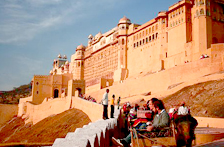 After breakfast, you will be picked up from your hotel and taken for a guided sightseeing tour of Jaipur and Amber. Tour includes visits to the following places of interest:
After breakfast, you will be picked up from your hotel and taken for a guided sightseeing tour of Jaipur and Amber. Tour includes visits to the following places of interest:
Hawa Mahal (Palace Of Winds): Built by Maharaja Sawaj Pratap Singh in 1799, the Hawa Mahal is one of Jaipur’s major landmarks, the facade of which is all pink windows and filigree screens. It was originally built to enable ladies of the royal household to watch the everyday life and processions of the city.
City Palace: It is still the home of the former royalty H.H Bhawani Singh Ji of Jaipur housing an extensive collection of art, carpets and old weapons.
Jantar Mantar (Observatory): It was built by Maharaja Jai Singh in 1728. At first glance, Jantar Mantar appears to be a curious collection of sculptures but in fact each construction has a specific purpose such as measuring the positions of stars, altitudes and azimuths, and calculating eclipses. The most striking instrument is the sundial with its 27 meter high gnomon. The shadow this casts moves up to 4 meter an hour.
Amber Fort: The Amber Fort is situated 11 kms away from Jaipur. Amber was once the ancient capital of Jaipur state. The Fort is a superb example of Rajput architecture, stunningly situated on a hillside and overlooking a lake, which reflects its terraces and ramparts. The climb to the fort is on gaily-bedecked elephants.
Overnight in Jaipur.
Day 13 - Drive Jaipur - Delhi (250 kms/05 hrs).
After leisurely breakfast at hotel, you will be met by our representative and assisted with check out formalities. You will then start your drive to Delhi.
On arrival at Delhi hotel, you will be assisted with check in formalities.
No activities are scheduled for this day. Spend the rest of the day enjoying the hotel facilities or exploring the city on your own.
Overnight in Delhi
Day 14 - Depart Delhi
Morning at leisure. Later in the day you are met by our representative at your hotel and assisted with checkout formalities, followed by transfer to International airport in time for your flight home.
Period |
Standard |
Deluxe |
Elite |
01st Oct to 30th June |
Us$ 1877 Per Pax |
Us$ 2277 Per Pax |
Us$ 2937 Per Pax |
Domestic airfare |
Us$ 320 Per Pax |
Us$ 320 Per Pax |
Us$ 320 Per Pax |
Cities |
Standard |
Deluxe |
Elite |
Delhi |
The Connaught |
The Claridges |
Taj Palace |
Varanasi |
HHI Varanasi |
Radisson |
Taj Gateway |
Khajuraho |
Ramada |
Radisson |
Taj Chandela |
Bandhavgarh |
Tiger Den |
Bandhav Vilas |
Bandhav Vilas |
Agra |
Howard Plaza |
Taj Gateway |
ITC Mughal |
Ranthambore |
Tiger Den |
Nahargarh / Dev Vilas |
Khem Vilas |
Jaipur |
Shahpura House / Alsisar Haveli |
Lemon Tree Premier |
Jai Mahal Palace |
Small supplements may apply for travel between 23rd October and 30th October, 05th November and 20th November, 20th December and 05th January and during the month of February .
Note: All the figures quoted above are net per person in US Dollars.
Inclusions:
Pan India Tourism
Unit of - AABYO SWACH YATRA HOSPITALITY PVT. LTD
Phone: 044-43595695
Cell: +91-75 300 25 888,
+91-9789930293, +91-9789080806, +91-9746125967
email: info@panindiatourism.com



